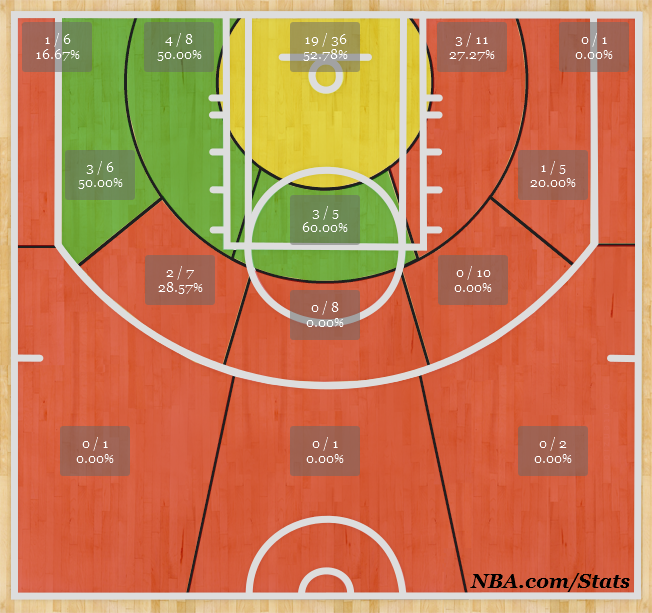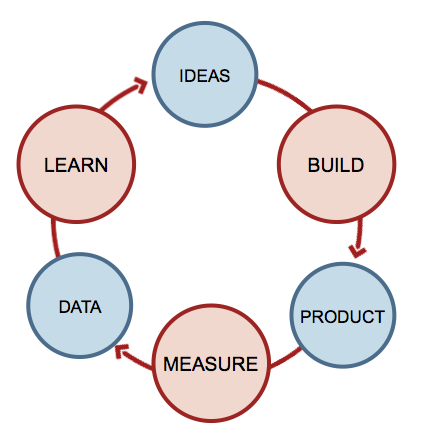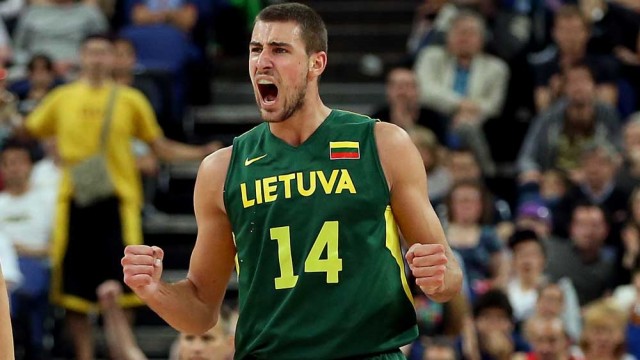Tie game with less than a minute left. What play do the Toronto Raptors turn to?
Fun fact: The Raptors were a league-best +195 in the fourth quarter last season. That’s 32 points better than the San Antonio Spurs, who ranked a distant second, and 63 better than the lowly third-place Miami Heat. If my memory is correct, the Heat and Spurs didn’t accomplish very much in 2013-14.
Much of that differential speaks to the Raptors’ depth, and Dwane Casey’s unwillingness to concede games. Most teams elect to play their bench units for the start of the fourth quarter in an effort to rest their the starters. The Raptors had the luxury of capitalizing with two starter quality pieces — Patrick Patterson and Greivis Vasquez — and DeMar DeRozan’s superhuman ability to endure strenuous workloads. Put two and two together, and fourth-quarter comebacks were something of a specialty for the Raptors. They had a fair bit of luck on their side.
Oddly enough, despite their overall fourth-quarter dominance, the Raptors were actually quite average offensively in “clutch” (+/- 5 points, less than 5 minutes left) scenarios, ranking just 13th in Net Rating. Depending on how you manipulate the clutch goalposts, the Raptors fared a tad better or a bit worse, but for the most part, the general theme was that the Raptors’ were a pretty average squad late in games.
In particular, the Raptors shot just 35.1 percent from the field with under a minute left in close games. That made me wonder, which clutch plays worked, and which ones didn’t?
Worked: Sidelines inbound to Amir Johnson
For this post, I looked at 97 clutch plays by the Raptors with the designation of clutch meaning with the score within 5 points under a minute left. Feel free to peruse the video yourself by clicking though this link.
The Raptors pet play in the clutch involved an sidelines inbound to Amir Johnson. The inbounder would input the ball, and look to run towards the middle with Johnson facilitating out of the high-post. From there, Johnson had multiple options at his disposal which made the play difficult to defend.
Variation 1: Hand-off, pull-up
The play starts with Terrence Ross setting a down screen on the player (Kemba Walker) defending the inbounder. Lowry inputs the ball to Johnson and uses the down screen from Ross while flashing to the top of the key. Johnson then turns for a hand-off, setting a second down screen in the process. It’s a thing of beauty when run correctly.
[gfy]ConventionalLimpingBuckeyebutterfly[/gfy]
The strength of this play is two-fold. First, Lowry is a fantastic shooter from above the break. Second, the suddenness of the play tends to catch opponents off-guard. Forcing Lowry’s defender to run through two down screens in quick succession creates a lot of drag, which basically ensures that Lowry to be open unless everything is switched. Even if everything is switched, the play still yields a mismatch with Amir’s man on Lowry.
Variation 2: Fake hand-off
Just as with the first play, the ball is inbounded to Amir and the inbounder flashes to the ball, but Amir drives intead of making the handoff, hoping to catch opponents off-guard. This works especially well when the defense anticipates the hand-off, and the big shades towards the inbounder.
[gfy]ScratchyVeneratedArchaeocete[/gfy]
In the clip above, Udonis Haslem defends the play correctly until the last second. He doesn’t cheat towards DeMar and stays with Amir step-for-step. The key to the play is the element of surprise, but of course, a little luck helps too. Given that the Heat struggled on the glass, it was a smart play-call to place the two Raptors bigs in the paint at the time of the shot. Amir misses, but Jonas Valanciunas is positioned on the doorstep, and easily collects a putback.
Variation 3: Blatant fouling
Hey, John Salmons could use all the help he could get. Amir deserves two assists on this play.
[gfy]DeafeningGentleGangesdolphin[/gfy]
Failed: Isolations for DeRozan
Oddly enough, the Raptors’ best one-on-one scorer was also its worst option in the clutch last season. DeRozan connected on just 33.6 percent of his field-goals, giving way to this Red Wedding-inspired shot-chart. Note that the vast majority of his attempts came from the dreaded mid-range area.
 Yes, he shot 4-for-29 from the right side of the court
Yes, he shot 4-for-29 from the right side of the court
This is not to say that DeRozan isn’t clutch, because the existence of “clutch” altogether is nebulous at best. There’s context to consider. DeRozan was almost always covered by the opposing team’s best defender(s). Even though he largely struggled to score for himself, DeRozan at least soaked up valuable defensive attention of which could have been deployed elsewhere. The results were what they were, but it wasn’t just DeRozan at fault. For example, the playcalls for him weren’t great either.
Variation 1: Basic Isolation
Nothing to see here. DeRozan gets the inbounds and everyone clears out. He then tries to beat his man one-on-one, and it just didn’t work whatsoever.
[gfy]AdolescentImportantAustraliansilkyterrier[/gfy]
There’s so much to critique on this play. First, why isolate DeMar and give him nothing to work with? Why not at give him a screen, and hope for a switch? Okay, bringing Joakim Noah onto DeMar might not actually help all that much as compared to Jimmy Butler, but then at least spread the floor. Note how Salmons, Lowry and Hansbrough are all crowded in the same quadrant of the court, with none of the three posing as actual threats to score. It’s hard to blame DeMar too much for this one.
Variation 2: Giving DeMar the ball in optimal matchups
To be fair to Casey and his coaching staff, the straight isolation sets for DeMar were rare. Take the play below for example. DeRozan receives two screens and ultimately ends up in a battle with Swaggy P, who is a pretty terrible defender. All in all, it’s not a bad playcall.
[gfy]BreakableSecondGlobefish[/gfy]
This one is on DeRozan. He cuts too close to the ball, which allows Swaggy to catch up to the play after being momentarily slowed by screens. DeMar tries to attack baseline, but Pau Gasol alertly leaves Chuck Hayes to protect the basket. DeMar then resets, but instead of hitting Hayes with the pass when he’s in a bad spot (note that Hayes has Ross wide open with an easy swing pass,) DeMar takes an ill-advised contested shot.
As a whole, DeRozan’s skills may not be best suited for the role he was given. He’s at his best when he’s attacking the basket. He is fantastic at drawing fouls and has the ability to finish at the rim through contact. However, teams often anticipate this and clog the paint, which takes away DeMar’s strength. The consequent leaves players open, but Patterson is the only stretch four on the roster, so defenses aren’t sacrificing very much to guard the rim. Altogether, play-calling can only do so much — they can’t substitute for a player’s skills. DeRozan falls victim to this.
Worked: Lowry in the backcourt
This one was by far my favorite. I only saw two examples of this play, but it’s rather ingenious in its simplicity. The ball is inbounded to Lowry in the backcourt, and he charges head-first to the basket, aided along by a high screen from Johnson. This gets Lowry going one-on-one with Johnson’s defender, whose only option is to back up to the basket with his hands in the air.
[gfy]GrossImpeccableAiredale[/gfy]
I’m a fan of the play because there are easy outs built in. The primary defender on Lowry in this play is Amir’s man (Paul Millsap), and when Lowry is in full gallop, it’s hard for any big man — even a mobile four like Millsap — to deny penetration. It’s also hard to send help on the play because the Raptors put three-point shooters in the corners (left: Steve Novak, right: DeRozan). Even if Lowry’s layup doesn’t fall, Amir is able to crash the glass with a small (Lowry’s man) vying for the boxout. Plus, with Lowry’s ball-handling ability, he can keep his dribble and reset if the matchup isn’t right. The play is extremely simple, but it’s effective.




